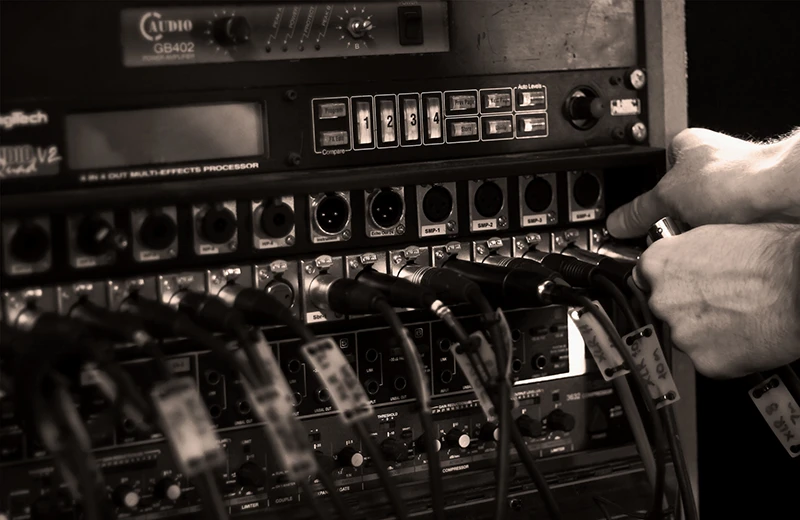If you made it through the post “
How Long Does It Take To Record A Song?”
you will have found that I prattled on endlessly about the various
complications common to recording sessions without actually answering
the question. For this I can only apologise, and promise to take a more
direct approach here, using a typical 5-piece rock band recording a
4-song EP as a template. Of course, every band is different, every
project is different, and every genre encompasses different challenges,
and therefore this is far from a one-size-fits-all methodology, however
an arrangement such as this is nonetheless very common, and hopefully
this will therefore provide some useful insight into what my working
methods are and what you can expect in a session.
So let’s say I’m tasked with recording a 5-piece rock band. They want
to record and mix their 4-song debut EP, and they want to keep their
costs down to a minimum. The band is comprised of:
- Lead vocalist/guitarist
- Guitarist/backing vocalist
- Bass player/backing vocalist
- Keyboard player
- Drummer
Let’s examine how that would work.
Prior to the session I open a conversation with the band, either by
email or in person at the studio, during which the specifics of their
project are discussed, with reference to any material that they consider
instructive to the kind of result they’re looking to achieve. We
discuss equipment requirements, production considerations, and any other
relevant details with a view to agreeing a workable plan, ensuring that
we are all on the same page and not approaching the project from
different directions. Given the budgetary limitations imposed in this
particular case, I recommend that we proceed with a relatively
straightforward recording with minimal overdubs, focusing instead on
capturing an organic, powerful representation of the band. The lead vocalist likes the sound of this because she favours a naturalistic
representation of her vocal style, with good room miking and no
double-tracking, and the rest of the band are likewise happy that their
instruments will be cleanly represented and not stylised in any way that
detracts from their natural sound.
I am asked by the drummer if I am likely to sample replace drums. I
reply “not unless absolutely necessary”. It may be the case that I ask
the drummer to record a few individual hits, just for safety, after the
main drum recording has been done, and perhaps I might use these hits to
repair some dodgy sections here and there if required, but I am a
strong advocate of recording as authentically as possible, utilising
room mics and mic selection to capture the natural character of the kit
and the performer, rather than digitally assaulting the material with a
sample library. I consider the latter approach to be fairly crass and
disingenuous for all kinds of reasons, and so unless there is a very
specific reason to do that, I try to avoid it.
We go on to discuss how the band might be most comfortable in
approaching the recording. I ask if they would favour playing
organically together in the same room, or layering instruments
separately to a click track and guide takes. Generally speaking I feel
disinclined to suggest the click track approach unless there is a
specific need for it, especially with regards to a traditional gigging
band setup, because to do so is to impose an artifice on the group that
pushes them away from their normal modus operandi, and potentially
introduces unwanted complications (please see the post “
To Click Or Not To Click”
for a wider discussion of this topic). It is decided that the organic
feel of a live band is preferable in this instance, and so we go on to
discuss how this is achieved. I will go into this in more detail later
in this article.
We finally discuss which instruments and amplifiers are to be used,
with the drummer deciding that the studio’s Gretsch kit would be a great
choice, combined with his own snare and cymbals, and the guitarists
respectively eyeing up the studio’s Mesa Boogie and AC30 amplifiers. We
all agree that these choices are appropriate given the sound they are
looking to achieve. The bass player has a rig of his own that he would
like to use. I then go on to make clear that the key to a great
recording is excellent preparation on the part of the band, and point
them to my blog posts, “
How Long Does It Take To Record A Song?” and “
How To Prepare For Your Session”.
With these considerations in mind, and given that this is the first
time we have worked together, I propose two “Weekender” sessions, with
the first two days for tracking instruments, followed by a break, and
then a second two days to record vocals and mix. During the initial
tracking session we focus on laying down the backbone of the songs
(drums, bass, guitars, keys and guide vocals), and if we work
efficiently with a well-rehearsed band then we should be able to produce
good results by the end of our two days. It is queried whether there
would be enough time on Day 2 to record vocals so that mixing can take
place on Day 3, however I suggest that, whilst it would be nice, it may
be pushing expectations too far given the quantity of material and the
range of instruments that need recording, editing and balancing. It is
often unwise to try to shoehorn a vocal recording into the dwindling
hours of a larger session, for several important reasons, not least that
everyone is generally tired by this point, and therefore producing a
good vocal performance with a weary brain and a ticking clock is not
very likely. What tends to happen is that the vocalist ultimately
rejects these takes and re-records them on a fresh day, and therefore
valuable time which could have been put to better use was in fact
wasted.
Before outlining the kind of agenda one might expect throughout a
4-day session like this, it is worth detailing the nature of a full-band
tracking session such as would be the case on Day 1. The following
description therefore documents a fairly typical procedure:
With the drum kit miked and sounding good, including various room and
ambient mics strategically positioned, the rest of the band is arranged
in the Live Room alongside the drummer, possibly excluding any
superfluous musicians with respect to the core components of the band.
So, for example, if the band can capture their fundamental energy when
stripped of their keyboard player and second guitarist, it may be the
case that these two individuals are either excluded from these original
takes, or repositioned elsewhere in the studio, perhaps in the Control
Room. Let’s imagine that is the case here.
So in the Live Room we have the drummer, bass player and
vocalist/guitarist, with the second guitarist and keyboard player in the
Control Room. The drum kit has lots of open mics positioned all around
it, including on the surfaces of walls and perhaps further out in the
hallway, and therefore it is important that no amplifiers are running
that can bleed into these mics. The bass and first guitar are DI’d and
run through an amp simulator of some kind, adjusted to approximate the
players’ usual sound, and then fed into theirs and the drummer’s
headphones. Likewise the keys and second guitar are DI’d, albeit from
the Control Room, where they are able to monitor either the Control Room
mix, or separate headphone mixes of their own. Some time is spent
establishing individual monitor mixes for everyone such that they are
able to comfortably hear themselves and whatever else is important to
them. The singer is provided a vocal mic, which she will use to record a
guide vocal during these initial recordings, taking care not to bleed
vocals into any drum mics during sensitive sections. The volume of a
vocalist with respect to a drum kit tends to be negligible so this is
seldom a cause for concern, however I make sure to keep my ears peeled
for any sections where the vocals may be inadvertently audible in the
drum mics. It is very unlikely that I will attempt any isolation with
large, cumbersome baffles because such panels are fairly ineffective and
don’t generally offer much advantage.
With everybody set up and ready to go, with levels checked and a few
test recordings under our belt, and ensuring that I have cued up a
suitable Control Room mix, we are ready for the band to let rip, which,
invariably, they do. It usually takes a few attempts for everyone to
feel totally comfortable, but once they are loosened up I get to
experience the pleasure of sitting back, putting my feet up and
listening to them sounding like their true uninhibited selves with a
fantastic sound. This part really is a pleasure for me! The beauty of
this approach is that, after recording all necessary material and
establishing the fundamental backbone of the songs, we have the option
of either re-amping the DI’d instruments, or overdubbing them
completely. Both offer the opportunity to focus more acutely on the
sound of each instrument, with due consideration given to tone and
microphone choice. Very often the various musicians will decide to
re-record their parts afresh, but because we are recording on top of a
live drum performance, we are now working from a template that maintains
an energy and character that may not have otherwise been captured.
After all four songs have been recorded (I will let the band dictate
how many takes they would like to do of each song — usually 3 is
plenty), it is likely that I will now align the grid of my DAW to map on
to each song in order to make any successive editing and overdubbing
easier. From here the process of layering instruments and vocals can
proceed as normal, in the safe knowledge that the fundamental basis of
the recording is true to what that band really sounds like.
Let’s now look at a typical agenda for a 4-day session:
Day 1
9.40am
Band arrives and loads in equipment. We have a brief strategy meeting while the drummer unpacks his kit in the Live Room.
10am
I begin preparing a project within my DAW while the drummer sets up and tunes his kit. Coffees are made.
11am
With the kit set up, tuned and sounding good, I proceed to start miking it.
1pm
Drum kit has been miked and sound checked, adjustments made, any
concerns addressed. We begin adding successive musicians into the fold;
first bass, then guitars, keys and vocals. By 2pm we are generally ready
to start recording, perhaps after a brief pause for lunch.
2pm
Recording begins.
4pm
All basic takes have now been recorded and we can proceed with re-amping
the bass guitar, feeding the cleanly recorded DI signal into a bass amp
and miking as necessary.
6pm
End of Day 1.
Day 2
10am
Band arrives. Material is reviewed. Any editing work takes place.
1pm
Guitar 1 is set up and recorded as a fresh overdub.
2pm
Guitar 2 is set up and recorded as a fresh overdub.
4pm
Keys are set up and recorded as a fresh overdub.
6pm
Rough mixes are exported and handed to the band. End of day 2.
Day 3
10am-6pm
Full day of vocal recording (including backing vocals) with any further
editing undertaken and projects tidied, ready for mixing.
Day 4
10am-6pm
Full day of mixing.
It is very important to note that the breakdown given above is a
guide only, not a statement of assurance that all sessions will follow
this course, as it presupposes a prepared, well-rehearsed band on a very
limited budget who have worked hard to eliminate any surprise problems
from their agenda. As stated in “
How Long Does It Take To Record A Song?”,
if it transpires that significant drum editing is required, or there
are technical challenges on the part of the band, then it is entirely
possible that more time may be required.
I should also reiterate that this is just one example of a band
setup, but there are of course many others. Acoustic guitar recordings
present different challenges, as does brass, piano, double bass, cello,
etc, etc. If you have any questions about your particular configuration,
I am only too happy to discuss it with you.




